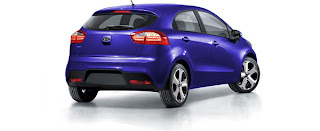GENEVA -- Kia has been on a tear, boasting enormous sales gains for the past 38 months. That rapid growth is due not only the company's new-found style but to the mechanicals beneath the sheet metal.
The stylistic charge is being led by Peter Schreyer, Kia's chief design officer, while Joachim Hahn, manager of powertrain engineering design and testing in Europe, is spearheading the powertrain revolution.
Design is all about proportion and the ability to evolve a company's look to keep it fresh, says Schreyer.
"You cannot sit on your butt and say it is good enough. Design is an ongoing process that involves learning and thinking."
This aspect of Schreyer's philosophy can be found in Kia's signature grille. Once dubbed the "tiger nose," it has evolved with each new vehicle. The latest iteration debuted on the oddly named but stylistically imbued Cee'd shown at last month's Geneva Motor Show.
Schreyer is tough on those who talk about design language.
"Talking about some crease lines that are on the body side, going up and down, is not design language, it is a cosmetic excuse for not getting the proper proportions in the first place and developing a clear architecture for a car. The basics were not right in the first place."
Regardless of what you call it, Schreyer has succeeded in leading a once stylistically moribund company out of the wilderness and into the promised land, where the accolades flow. Under his guidance, Kia has picked up a cabinet's worth of hardware -- specifically a number of prestigious Red Dot design awards.
The award dates back to 1955 and is one of the world's largest and most distinguished design competitions. In 2012, 1,800 large companies and independent designers from 58 countries sent more than 4,500 submissions to the product design category (there are a total of 19 categories).
This year, Kia's subcompact Picanto and recently released Rio were awarded Red Dots, bringing the company's total to seven. The Soul won in 2009, the European Venga mini-minivan in 2010, while the Sportage and Optima claimed top spots in 2011. The Optima also went on to be... more Kia charges out of wilderness - Winnipeg Free Press Autos
The stylistic charge is being led by Peter Schreyer, Kia's chief design officer, while Joachim Hahn, manager of powertrain engineering design and testing in Europe, is spearheading the powertrain revolution.
Design is all about proportion and the ability to evolve a company's look to keep it fresh, says Schreyer.
"You cannot sit on your butt and say it is good enough. Design is an ongoing process that involves learning and thinking."
This aspect of Schreyer's philosophy can be found in Kia's signature grille. Once dubbed the "tiger nose," it has evolved with each new vehicle. The latest iteration debuted on the oddly named but stylistically imbued Cee'd shown at last month's Geneva Motor Show.
Schreyer is tough on those who talk about design language.
"Talking about some crease lines that are on the body side, going up and down, is not design language, it is a cosmetic excuse for not getting the proper proportions in the first place and developing a clear architecture for a car. The basics were not right in the first place."
Regardless of what you call it, Schreyer has succeeded in leading a once stylistically moribund company out of the wilderness and into the promised land, where the accolades flow. Under his guidance, Kia has picked up a cabinet's worth of hardware -- specifically a number of prestigious Red Dot design awards.
The award dates back to 1955 and is one of the world's largest and most distinguished design competitions. In 2012, 1,800 large companies and independent designers from 58 countries sent more than 4,500 submissions to the product design category (there are a total of 19 categories).
This year, Kia's subcompact Picanto and recently released Rio were awarded Red Dots, bringing the company's total to seven. The Soul won in 2009, the European Venga mini-minivan in 2010, while the Sportage and Optima claimed top spots in 2011. The Optima also went on to be... more Kia charges out of wilderness - Winnipeg Free Press Autos





